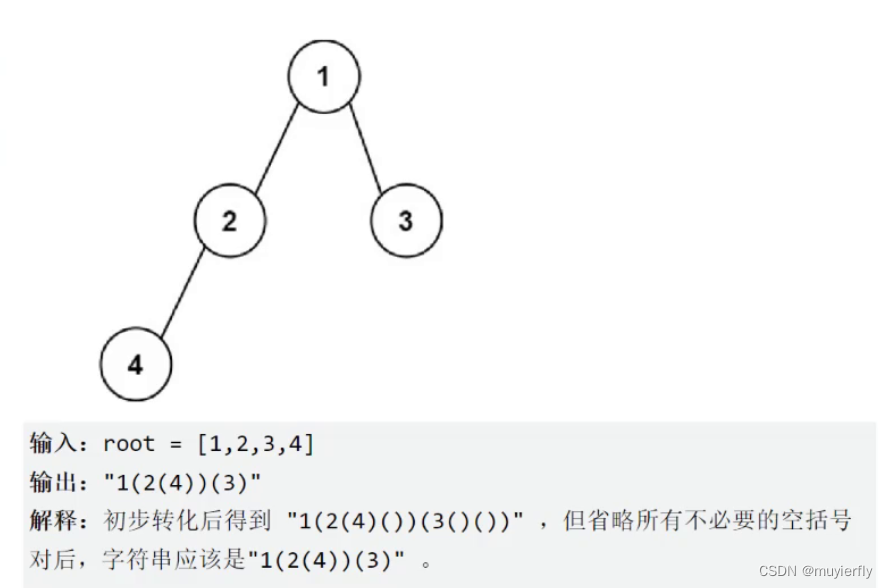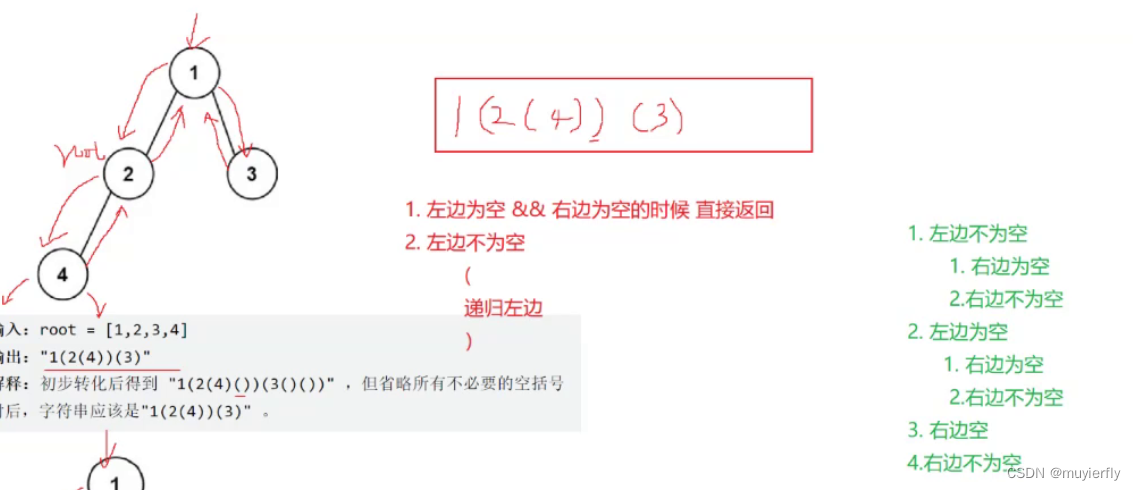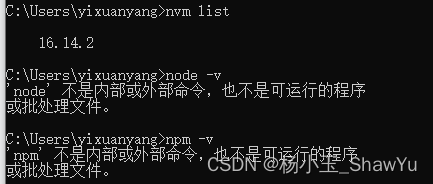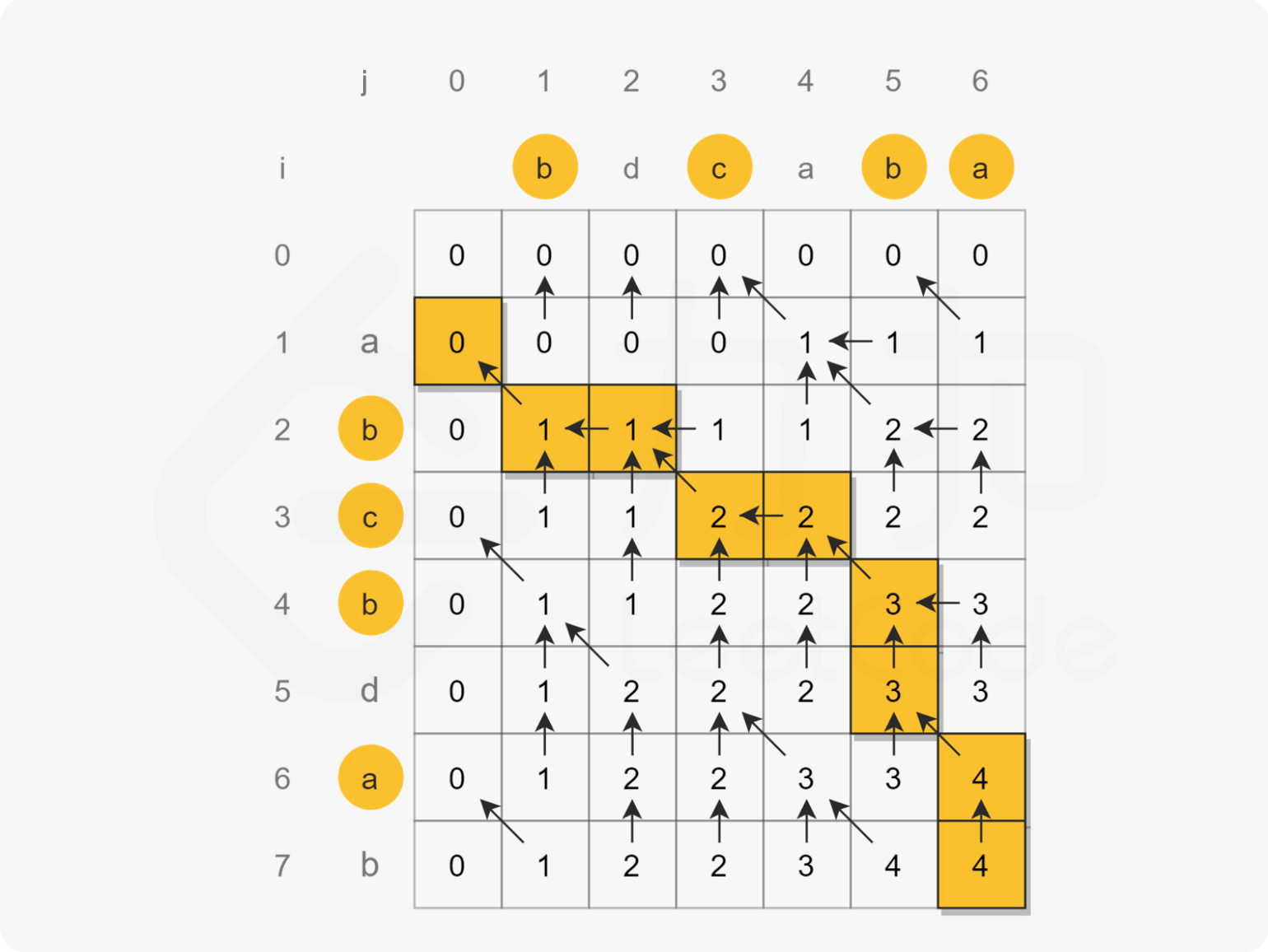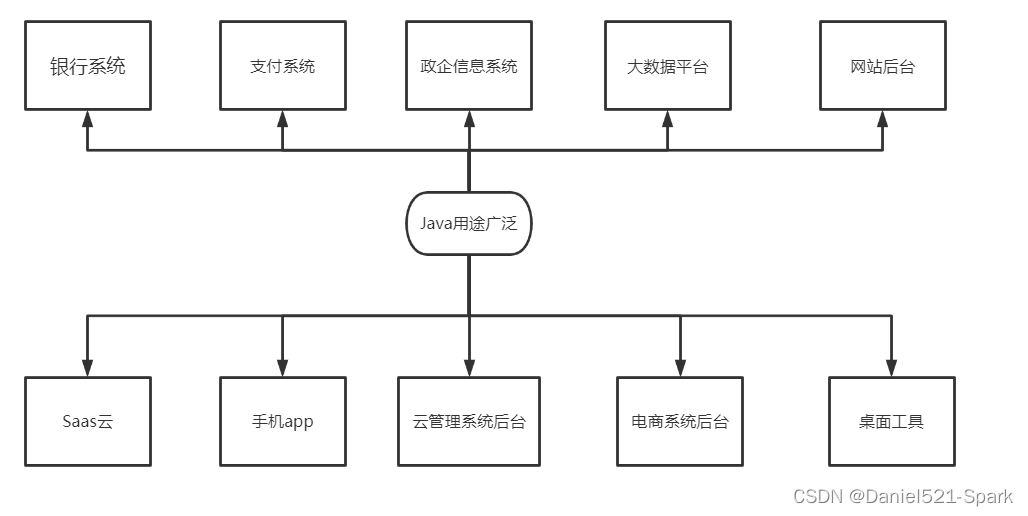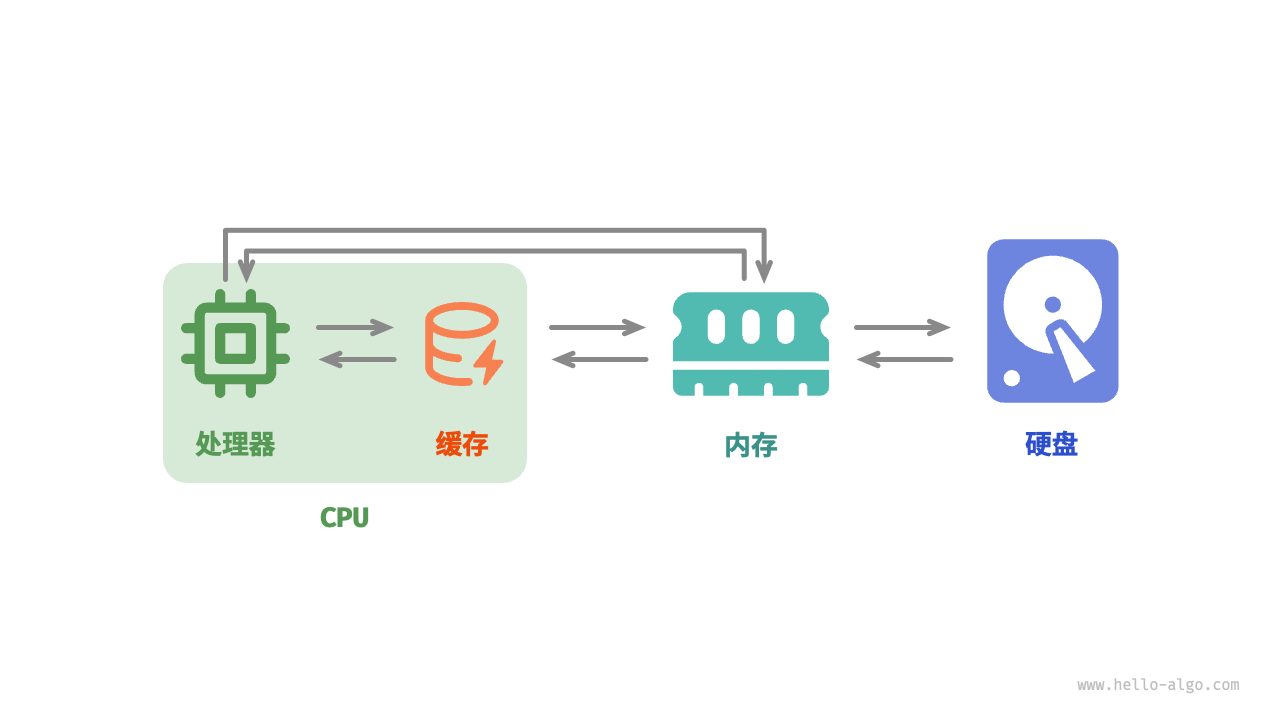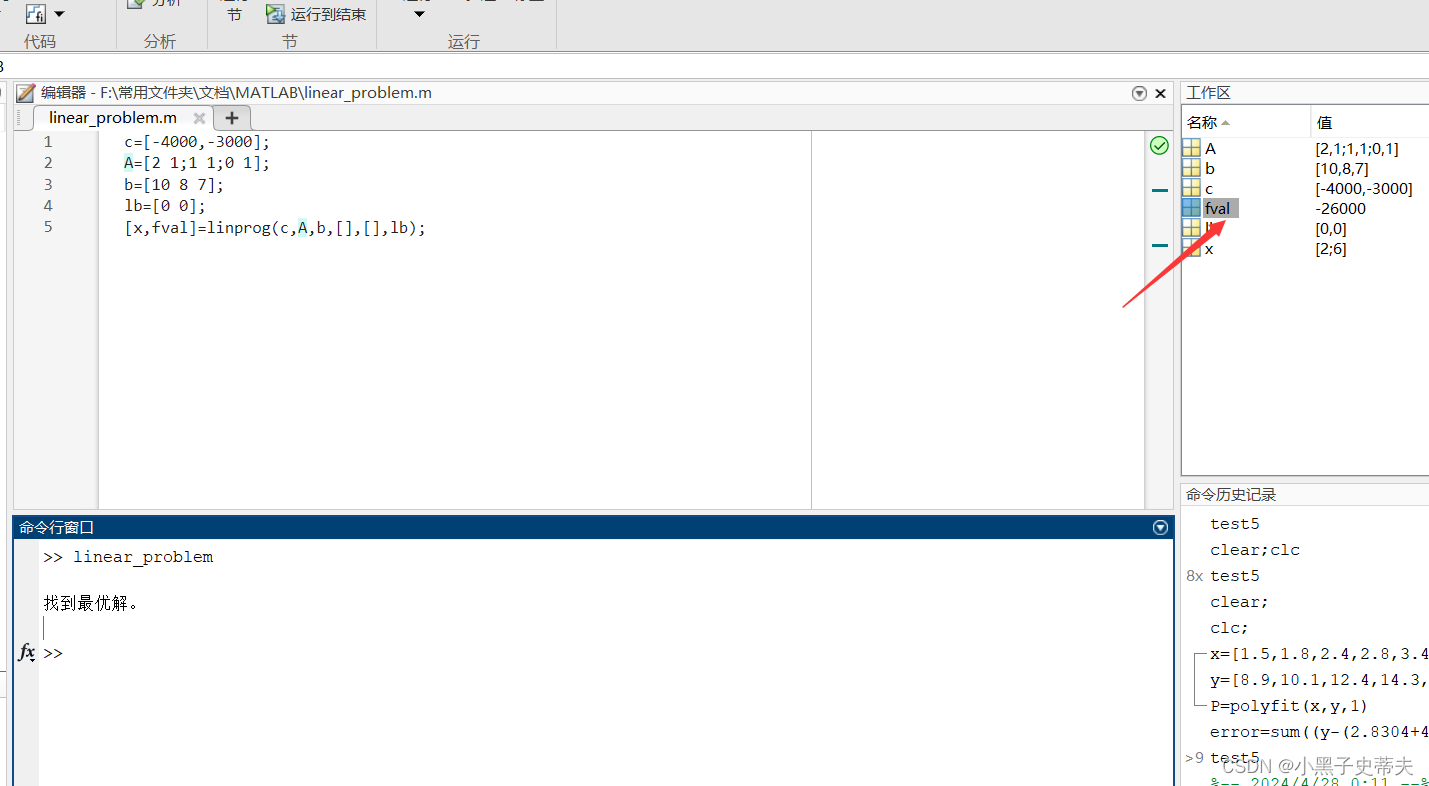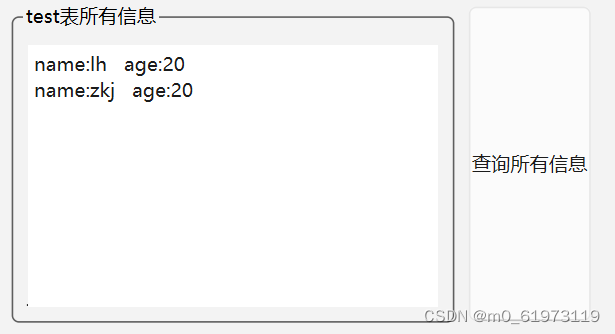1. 二叉树前序非递归遍历实现 。
. - 力扣(LeetCode)
递归的实现
public List<TreeNode> preOrder1(TreeNode root){
List<TreeNode> ret=new ArrayList<>();
if(root == null)
return ret;
ret.add(root);
List<TreeNode> leftTree = preOrder1(root.left);
ret.addAll(leftTree);
List<TreeNode> rightTree = preOrder1(root.right);
ret.addAll(rightTree);
return ret;
}与栈相结合
public void preOrderNor(TreeNode root) { if(root == null) return; Stack<TreeNode> stack = new Stack<>(); TreeNode cur = root; TreeNode top = null; while (cur != null || !stack.isEmpty()) { while (cur != null) { stack.push(cur); System.out.print(cur.val + " "); cur = cur.left; } top = stack.pop(); cur = top.right; } }
2. 二叉树中序非递归遍历实现。
. - 力扣(LeetCode)
3. 二叉树后序非递归遍历实现。
. - 力扣(LeetCode)
4. 检查两颗树是否相同。
. - 力扣(LeetCode)

/**
* Definition for a binary tree node.
* public class TreeNode {
* int val;
* TreeNode left;
* TreeNode right;
* TreeNode() {}
* TreeNode(int val) { this.val = val; }
* TreeNode(int val, TreeNode left, TreeNode right) {
* this.val = val;
* this.left = left;
* this.right = right;
* }
* }
*/
class Solution {
public boolean isSameTree(TreeNode p, TreeNode q) {
//一个为空一个不为空
if((p==null&&q!=null)||(p!=null&&q==null)){
return false;
}
//两个都为空
if(p==null&&q==null){
return true;
}
//两个都不为空
if(p.val!=q.val){
return false;
}
return isSameTree(p.right, q.right)&&isSameTree(p.left, q.left);
}
}5. 另一颗树的子树。
. - 力扣(LeetCode)
//判断左数和其是否相同
/**
* Definition for a binary tree node.
* public class TreeNode {
* int val;
* TreeNode left;
* TreeNode right;
* TreeNode() {}
* TreeNode(int val) { this.val = val; }
* TreeNode(int val, TreeNode left, TreeNode right) {
* this.val = val;
* this.left = left;
* this.right = right;
* }
* }
*/
class Solution {
public boolean isSameTree(TreeNode p, TreeNode q) {
if(p == null && q != null || p != null && q == null ) {
return false;
}
//两个都为空呢?
if(p == null && q == null) {
return true;
}
//一定是两个引用 都不为空 | 两个都不为空呢?
if(p.val != q.val) {
return false;
}
return isSameTree(p.left,q.left) &&
isSameTree(p.right,q.right);
}
public boolean isSubtree(TreeNode root, TreeNode subRoot) {
if(root==null){
return false;
}
if(isSameTree(root,subRoot)){
return true;
}
if(isSubtree(root.left,subRoot)){
return true;
}
if(isSubtree(root.right,subRoot)){
return true;
}
return false;
}
}6.翻转二叉树。
. - 力扣(LeetCode)
/**
* Definition for a binary tree node.
* public class TreeNode {
* int val;
* TreeNode left;
* TreeNode right;
* TreeNode() {}
* TreeNode(int val) { this.val = val; }
* TreeNode(int val, TreeNode left, TreeNode right) {
* this.val = val;
* this.left = left;
* this.right = right;
* }
* }
*/
class Solution {
public TreeNode invertTree(TreeNode root) {
if(root==null){
return null;
}
TreeNode tmp=root.left;
root.left=root.right;
root.right=tmp;
invertTree(root.left);
invertTree(root.right);
return root;
}
}7. 判断一颗二叉树是否是平衡二叉树。
但是上述方式复杂度较高
上述代码速度很慢!!!
. - 力扣(LeetCode)
/**
* Definition for a binary tree node.
* public class TreeNode {
* int val;
* TreeNode left;
* TreeNode right;
* TreeNode() {}
* TreeNode(int val) { this.val = val; }
* TreeNode(int val, TreeNode left, TreeNode right) {
* this.val = val;
* this.left = left;
* this.right = right;
* }
* }
*/
class Solution {
public int getHeight(TreeNode root) {
if(root == null)
return 0;
int leftHeight = getHeight(root.left);
int rightHeight = getHeight(root.right);
if(leftHeight>=0&&rightHeight>=0&&Math.abs(leftHeight-rightHeight)<=1){
return Math.max(leftHeight,rightHeight)+1;
}else{
return -1;
}
}
public boolean isBalanced(TreeNode root) {
if(root==null){
return true;
}
return getHeight(root)>=0;
}
}8.对称二叉树。
. - 力扣(LeetCode)
/**
* Definition for a binary tree node.
* public class TreeNode {
* int val;
* TreeNode left;
* TreeNode right;
* TreeNode() {}
* TreeNode(int val) { this.val = val; }
* TreeNode(int val, TreeNode left, TreeNode right) {
* this.val = val;
* this.left = left;
* this.right = right;
* }
* }
*/
class Solution {
public boolean isSymmetric(TreeNode root) {
if(root==null){
return true;
}
return isSymmetricChild(root.left,root.right);
}
public boolean isSymmetricChild(TreeNode p,TreeNode q){
if((p==null&&q!=null)||(p!=null&&q==null)){
return false;
}
if(p==null&&q==null){
return true;
}
if(p.val!=q.val){
return false;
}
return isSymmetricChild(p.left,q.right)&&isSymmetricChild(p.right,q.left);
}
}9.二叉树的构建及遍历。
二叉树遍历_牛客题霸_牛客网
hasNext、hasNextLine、next、nextLine保姆级详解-CSDN博客
import java.util.Scanner; //从头到尾进行书写 class TreeNode{ char val; TreeNode left; TreeNode right; //无参构造 TreeNode(){ } //有参构造 TreeNode(char val){ this.val=val; } } // 注意类名必须为 Main, 不要有任何 package xxx 信息 public class Main { public static void main(String[] args) { Scanner in = new Scanner(System.in); // 注意 hasNext 和 hasNextLine 的区别 while (in.hasNextLine()) { // 注意 while 处理多个 case String str=in.nextLine(); TreeNode root=createTree(str); inOrder(root); } } public static int i=0; public static TreeNode createTree(String str){ TreeNode root =null; if(str.charAt(i)!='#'){ root=new TreeNode(str.charAt(i)); i++; root.left=createTree(str); root.right=createTree(str); }else{ i++; } return root; } public static void inOrder(TreeNode root){ if(root==null){ return; } inOrder(root.left); System.out.print(root.val+" "); inOrder(root.right); } }
10.二叉树的分层遍历
. - 力扣(LeetCode)
/**
* Definition for a binary tree node.
* public class TreeNode {
* int val;
* TreeNode left;
* TreeNode right;
* TreeNode() {}
* TreeNode(int val) { this.val = val; }
* TreeNode(int val, TreeNode left, TreeNode right) {
* this.val = val;
* this.left = left;
* this.right = right;
* }
* }
*/
class Solution {
public List<List<Integer>> levelOrder(TreeNode root) {
List<List<Integer>> ret = new ArrayList<>();
if(root == null) {
return ret;
}
Queue<TreeNode> queue = new LinkedList<>();
queue.offer(root);
while (!queue.isEmpty()) {
//求一下当前队列的大小 4
int size = queue.size();//4
List<Integer> tmp = new ArrayList<>();
while (size != 0) {
// 出队列4次 相当于把 这一层的节点都 出队了
TreeNode cur = queue.poll();
//System.out.print(cur.val+" ");
tmp.add(cur.val);
size--;//0
if(cur.left != null) {
queue.offer(cur.left);
}
if(cur.right != null) {
queue.offer(cur.right);
}
}
ret.add(tmp);
}
return ret;
}
}11.给定一个二叉树, 找到该树中两个指定节点的最近公共祖先 。
. - 力扣(LeetCode)
方法一:
/**
* Definition for a binary tree node.
* public class TreeNode {
* int val;
* TreeNode left;
* TreeNode right;
* TreeNode(int x) { val = x; }
* }
*/
class Solution {
public TreeNode lowestCommonAncestor(TreeNode root, TreeNode p, TreeNode q) {
if(root == null) {
return null;
}
if(root == p || root == q) {
return root;
}
TreeNode leftTree = lowestCommonAncestor(root.left,p,q);
TreeNode rightTree = lowestCommonAncestor(root.right,p,q);
if(leftTree != null && rightTree != null) {
return root;
}else if(leftTree != null) {
return leftTree;
}else {
return rightTree;
}
}
}方法二:与栈相结合
/**
* 找到root 到 node 之间路径上 的 所有 的 节点 存储到stack中
*
* @param root
* @param node
* @param stack
* @return
*/
private boolean getPath(TreeNode root, TreeNode node, Stack<TreeNode> stack) {
if(root == null || node == null) {
return false;
}
stack.push(root);
if(root == node) {
return true;
}
boolean flg = getPath(root.left,node,stack);
if(flg) {
return true;
}
boolean flg2 = getPath(root.right,node,stack);
if(flg2) {
return true;
}
stack.pop();
return false;
}
public TreeNode lowestCommonAncestor2(TreeNode root, TreeNode p, TreeNode q) {
if(root == null) {
return null;
}
Stack<TreeNode> stackP = new Stack<>();
Stack<TreeNode> stackQ = new Stack<>();
getPath(root,p,stackP);
getPath(root,q,stackQ);
//对栈的操作
int sizeP = stackP.size();
int sizeQ = stackQ.size();
if(sizeP > sizeQ) {
int size = sizeP - sizeQ;
while (size != 0) {
stackP.pop();
size--;
}
}else {
int size = sizeQ - sizeP;
while (size != 0) {
stackQ.pop();
size--;
}
}
//两个栈当中 元素的个数是相同的
while (!stackP.isEmpty() && !stackQ.isEmpty()) {
if(stackP.peek() .equals(stackQ.peek())) {
return stackP.peek();
}
stackP.pop();
stackQ.pop();
}
return null;
}
12. 根据一棵树的前序遍历与中序遍历构造二叉树。
. - 力扣(LeetCode)
先序遍历确定根,根据中序遍历确定左树和右树
/**
* Definition for a binary tree node.
* public class TreeNode {
* int val;
* TreeNode left;
* TreeNode right;
* TreeNode() {}
* TreeNode(int val) { this.val = val; }
* TreeNode(int val, TreeNode left, TreeNode right) {
* this.val = val;
* this.left = left;
* this.right = right;
* }
* }
*/
class Solution {
public int priIndex;
public TreeNode buildTree(int[] preorder, int[] inorder) {
return buildTreeChild(preorder,inorder,0,inorder.length-1);
}
private TreeNode buildTreeChild(int[] preorder,int[] inorder,int inbegin,int inend) {
//1. 没有左树 或者 没有右树了
if(inbegin > inend) {
return null;
}
//2.创建根节点
TreeNode root = new TreeNode(preorder[priIndex]);
//3.从中序遍历当中 找到根节点所在的下标
int rootIndex = findIndex(inorder,inbegin,inend,preorder[priIndex]);
if(rootIndex == -1) {
return null;
}
priIndex++;
//4. 创建左子树 和 右子树
root.left = buildTreeChild(preorder,inorder,inbegin,rootIndex-1);
root.right = buildTreeChild(preorder,inorder,rootIndex+1,inend);
return root;
}
private int findIndex(int[] inorder,int inbegin,int inend,int key) {
for(int i = inbegin;i <= inend;i++) {
if(inorder[i] == key) {
return i;
}
}
return -1;
}
}13.根据一棵树的中序遍历与后序遍历构造二叉树
. - 力扣(LeetCode)
/**
* Definition for a binary tree node.
* public class TreeNode {
* int val;
* TreeNode left;
* TreeNode right;
* TreeNode() {}
* TreeNode(int val) { this.val = val; }
* TreeNode(int val, TreeNode left, TreeNode right) {
* this.val = val;
* this.left = left;
* this.right = right;
* }
* }
*/
class Solution {
public int postIndex ;
public TreeNode buildTree(int[] inorder, int[] postorder) {
postIndex = postorder.length-1;
return buildTreeChild(postorder,inorder,0,inorder.length-1);
}
private TreeNode buildTreeChild(int[] postorder,int[] inorder,int inbegin,int inend) {
//1. 没有左树 或者 没有右树了
if(inbegin > inend) {
return null;
}
//2.创建根节点
TreeNode root = new TreeNode(postorder[postIndex]);
//3.从中序遍历当中 找到根节点所在的下标
int rootIndex = findIndex(inorder,inbegin,inend,postorder[postIndex]);
if(rootIndex == -1) {
return null;
}
postIndex--;
//4. 创建左子树 和 右子树
root.right = buildTreeChild(postorder,inorder,rootIndex+1,inend);
root.left = buildTreeChild(postorder,inorder,inbegin,rootIndex-1);
return root;
}
private int findIndex(int[] inorder,int inbegin,int inend,int key) {
for(int i = inbegin;i <= inend;i++) {
if(inorder[i] == key) {
return i;
}
}
return -1;
}
}14.二叉树创建字符串。
. - 力扣(LeetCode)
public String tree2str(TreeNode root) { StringBuilder stringBuilder = new StringBuilder(); tree2strChild(root,stringBuilder); return stringBuilder.toString(); } private void tree2strChild(TreeNode t,StringBuilder stringBuilder) { if(t == null) { return; } stringBuilder.append(t.val); if(t.left != null) { stringBuilder.append("("); tree2strChild(t.left,stringBuilder); stringBuilder.append(")"); }else { if(t.right == null) { return; }else{ stringBuilder.append("()"); } } if(t.right != null) { stringBuilder.append("("); tree2strChild(t.right,stringBuilder); stringBuilder.append(")"); }else { return; } } public void preOrderNor(TreeNode root) { if(root == null) return; Stack<TreeNode> stack = new Stack<>(); TreeNode cur = root; TreeNode top = null; while (cur != null || !stack.isEmpty()) { while (cur != null) { stack.push(cur); System.out.print(cur.val + " "); cur = cur.left; } top = stack.pop(); cur = top.right; } } public void inOrderNor(TreeNode root) { if(root == null) return; Stack<TreeNode> stack = new Stack<>(); TreeNode cur = root; TreeNode top = null; while (cur != null || !stack.isEmpty()) { while (cur != null) { stack.push(cur); cur = cur.left; } top = stack.pop(); System.out.print(top.val + " "); cur = top.right; } }












